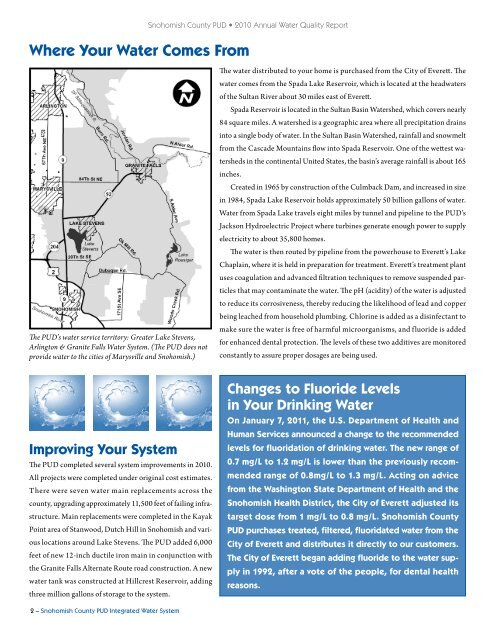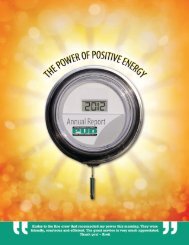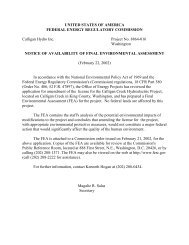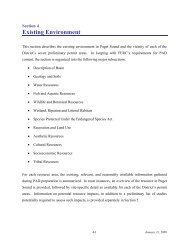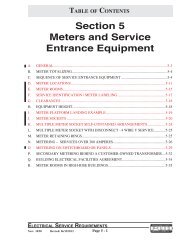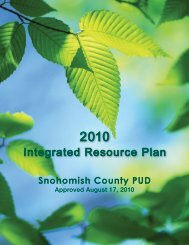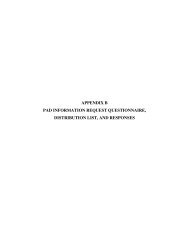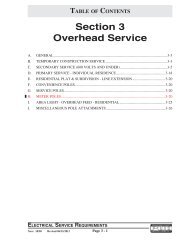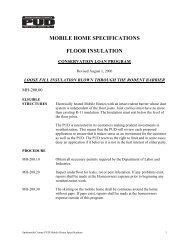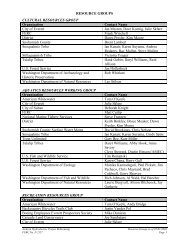Your Water Is Safe To Drink! - Snohomish County PUD
Your Water Is Safe To Drink! - Snohomish County PUD
Your Water Is Safe To Drink! - Snohomish County PUD
You also want an ePaper? Increase the reach of your titles
YUMPU automatically turns print PDFs into web optimized ePapers that Google loves.
<strong>Snohomish</strong> <strong>County</strong> <strong>PUD</strong> • 2010 Annual <strong>Water</strong> Quality Report<br />
Where <strong>Your</strong> <strong>Water</strong> Comes From<br />
The <strong>PUD</strong>’s water service territory: Greater Lake Stevens,<br />
Arlington & Granite Falls <strong>Water</strong> System. (The <strong>PUD</strong> does not<br />
provide water to the cities of Marysville and <strong>Snohomish</strong>.)<br />
The water distributed to your home is purchased from the City of Everett. The<br />
water comes from the Spada Lake Reservoir, which is located at the headwaters<br />
of the Sultan River about 30 miles east of Everett.<br />
Spada Reservoir is located in the Sultan Basin <strong>Water</strong>shed, which covers nearly<br />
84 square miles. A watershed is a geographic area where all precipitation drains<br />
into a single body of water. In the Sultan Basin <strong>Water</strong>shed, rainfall and snowmelt<br />
from the Cascade Mountains flow into Spada Reservoir. One of the wettest watersheds<br />
in the continental United States, the basin’s average rainfall is about 165<br />
inches.<br />
Created in 1965 by construction of the Culmback Dam, and increased in size<br />
in 1984, Spada Lake Reservoir holds approximately 50 billion gallons of water.<br />
<strong>Water</strong> from Spada Lake travels eight miles by tunnel and pipeline to the <strong>PUD</strong>’s<br />
Jackson Hydroelectric Project where turbines generate enough power to supply<br />
electricity to about 35,800 homes.<br />
The water is then routed by pipeline from the powerhouse to Everett’s Lake<br />
Chaplain, where it is held in preparation for treatment. Everett’s treatment plant<br />
uses coagulation and advanced filtration techniques to remove suspended particles<br />
that may contaminate the water. The pH (acidity) of the water is adjusted<br />
to reduce its corrosiveness, thereby reducing the likelihood of lead and copper<br />
being leached from household plumbing. Chlorine is added as a disinfectant to<br />
make sure the water is free of harmful microorganisms, and f luoride is added<br />
for enhanced dental protection. The levels of these two additives are monitored<br />
constantly to assure proper dosages are being used.<br />
Improving <strong>Your</strong> System<br />
The <strong>PUD</strong> completed several system improvements in 2010.<br />
All projects were completed under original cost estimates.<br />
There were seven water main replacements across the<br />
county, upgrading approximately 11,500 feet of failing infrastructure.<br />
Main replacements were completed in the Kayak<br />
Point area of Stanwood, Dutch Hill in <strong>Snohomish</strong> and various<br />
locations around Lake Stevens. The <strong>PUD</strong> added 6,000<br />
feet of new 12-inch ductile iron main in conjunction with<br />
the Granite Falls Alternate Route road construction. A new<br />
water tank was constructed at Hillcrest Reservoir, adding<br />
three million gallons of storage to the system.<br />
Changes to Fluoride Levels<br />
in <strong>Your</strong> <strong>Drink</strong>ing <strong>Water</strong><br />
On January 7, 2011, the U.S. Department of Health and<br />
Human Services announced a change to the recommended<br />
levels for fluoridation of drinking water. The new range of<br />
0.7 mg/L to 1.2 mg/L is lower than the previously recommended<br />
range of 0.8mg/L to 1.3 mg/L. Acting on advice<br />
from the Washington State Department of Health and the<br />
<strong>Snohomish</strong> Health District, the City of Everett adjusted its<br />
target dose from 1 mg/L to 0.8 mg/L. <strong>Snohomish</strong> <strong>County</strong><br />
<strong>PUD</strong> purchases treated, filtered, fluoridated water from the<br />
City of Everett and distributes it directly to our customers.<br />
The City of Everett began adding fluoride to the water supply<br />
in 1992, after a vote of the people, for dental health<br />
reasons.<br />
2 – <strong>Snohomish</strong> <strong>County</strong> <strong>PUD</strong> Integrated <strong>Water</strong> System


